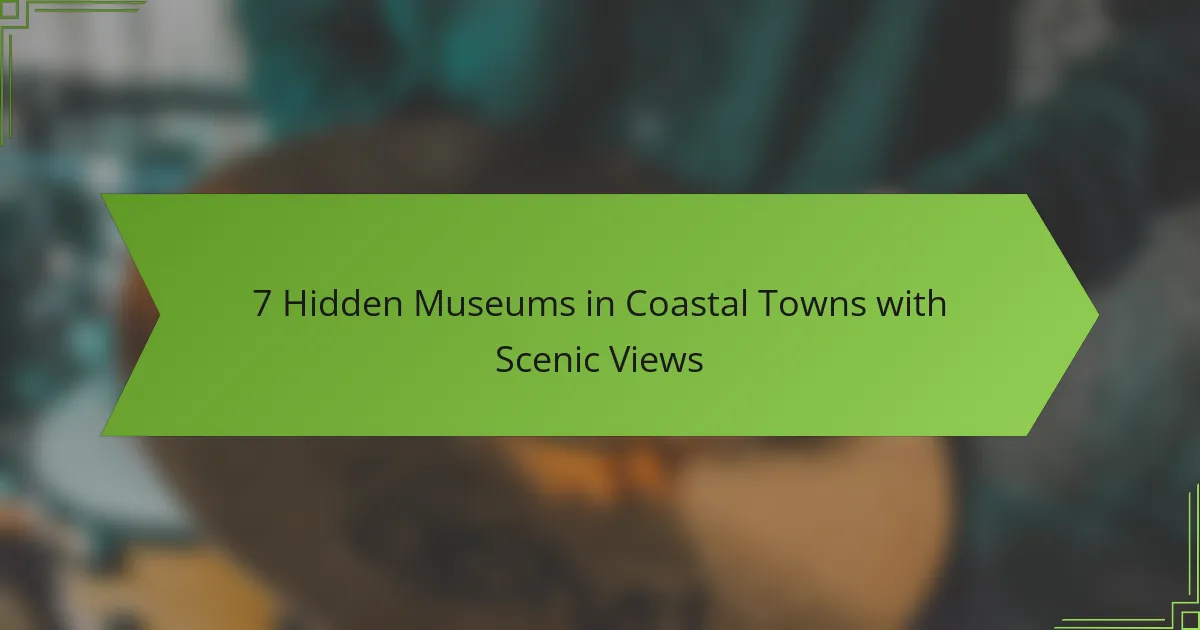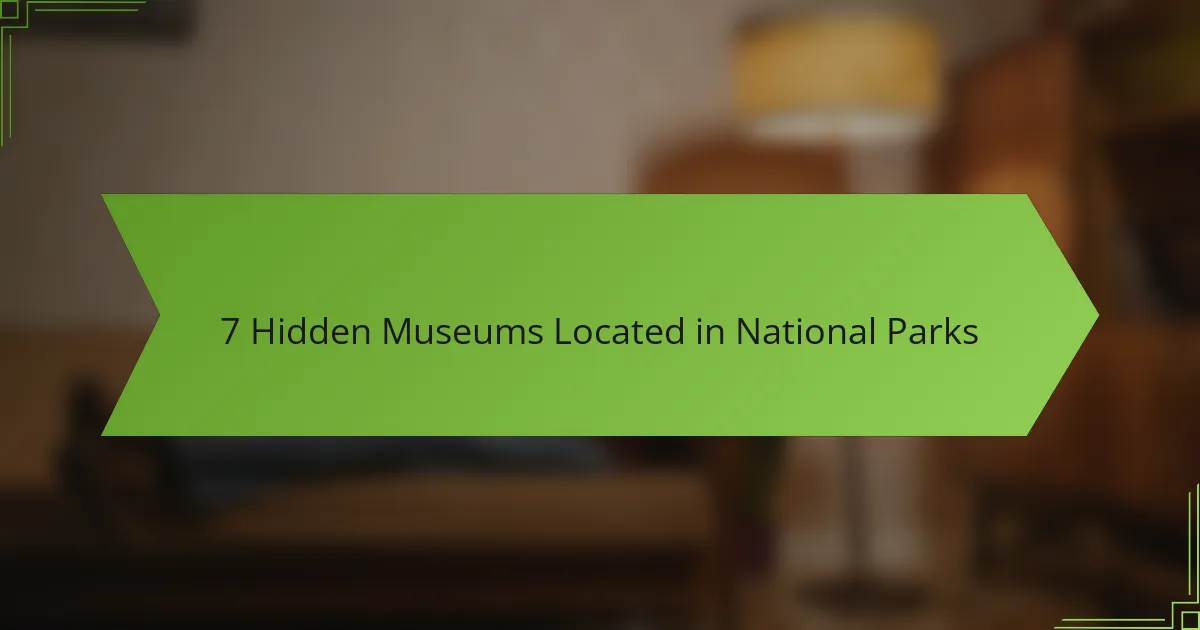Discovering hidden museums in coastal towns not only unveils unique aspects of local maritime history and culture but also rewards visitors with breathtaking scenic views. These lesser-known gems provide an intimate experience, allowing for exploration away from the usual tourist crowds. As you plan your visit, consider the stunning vistas that accompany these cultural treasures, enhancing your journey through both art and nature.

What Are the Best Hidden Museums in Coastal Towns?
The best hidden museums in coastal towns offer unique insights into local maritime history, culture, and art, often accompanied by stunning views. These lesser-known attractions provide an intimate experience away from the crowds, making them perfect for exploration.
Maritime Museum of San Diego
The Maritime Museum of San Diego showcases a rich collection of historic ships and exhibits related to maritime history. Visitors can explore various vessels, including the Star of India, the world’s oldest active sailing ship, and enjoy interactive displays that highlight the region’s naval heritage.
Consider taking a guided tour to gain deeper insights into the museum’s artifacts and their significance. The museum is located along the picturesque San Diego Bay, providing a scenic backdrop for your visit.
Whaling Museum in Cold Spring Harbor
The Whaling Museum in Cold Spring Harbor focuses on the history of whaling and its impact on the local community. This small yet informative museum features exhibits that detail the whaling industry, including artifacts, models, and interactive displays.
Plan your visit during special events or lectures for a more enriching experience. The museum is situated near beautiful waterfront views, making it a pleasant stop while exploring the charming town.
Fishermen’s Museum in Gloucester
The Fishermen’s Museum in Gloucester celebrates the town’s rich fishing heritage through exhibits that highlight the lives of local fishermen. The museum features photographs, tools, and stories that illustrate the challenges and triumphs of the fishing industry.
Take time to engage with the knowledgeable staff, who can share personal anecdotes and insights about Gloucester’s fishing community. The museum is conveniently located near the harbor, allowing for a scenic stroll afterward.
Coastal Discovery Museum in Hilton Head
The Coastal Discovery Museum in Hilton Head Island offers a blend of natural history and cultural heritage, focusing on the region’s coastal ecosystems. Visitors can explore interactive exhibits, nature trails, and even join guided tours to learn about local wildlife and conservation efforts.
Check the museum’s schedule for seasonal events, such as nature walks or educational programs for families. The museum’s location near beautiful beaches enhances the overall experience, making it a great spot for both learning and leisure.
Santa Cruz Surfing Museum
The Santa Cruz Surfing Museum is dedicated to the history of surfing in California, showcasing artifacts, photographs, and memorabilia that highlight the sport’s evolution. Housed in a historic lighthouse, the museum offers stunning ocean views alongside its exhibits.
Don’t miss the opportunity to explore the nearby surf spots after your visit. The museum’s intimate setting allows for a personal connection to the local surfing culture, making it a must-see for enthusiasts and casual visitors alike.

What Scenic Views Can You Expect?
Coastal towns often offer breathtaking scenic views that enhance the experience of visiting hidden museums. Expect stunning vistas of the ocean, harbors, and cliffs that complement the rich history and culture found within these unique spaces.
Harbor Views at Maritime Museum of San Diego
The Maritime Museum of San Diego provides captivating harbor views that are integral to its maritime heritage. Visitors can enjoy panoramic sights of the San Diego Bay while exploring historic ships and exhibits detailing naval history.
Consider taking a guided tour to fully appreciate the stories behind each vessel. The museum’s location allows for picturesque sunset views, making it an ideal spot for photography enthusiasts.
Oceanfront Views at Whaling Museum
The Whaling Museum, located in a charming coastal town, offers stunning oceanfront views that enhance its exhibits on whaling history. The museum’s large windows provide a perfect backdrop of the sea, creating a serene atmosphere for visitors.
While exploring the museum, take a moment to step outside for fresh ocean air and to enjoy the sound of waves. This museum often features educational programs that highlight marine conservation, making it a great stop for families.
Cliffside Views at Fishermen’s Museum
Fishermen’s Museum is perched on a cliff, offering breathtaking views of the coastline and the surrounding landscape. The elevated position allows visitors to see boats navigating the waters below, creating a picturesque setting for learning about local fishing traditions.
When visiting, be sure to check out the outdoor viewing areas, which provide excellent opportunities for spotting marine wildlife. The museum often hosts community events, so look for seasonal activities that take advantage of the stunning cliffside views.

How to Plan Your Visit to Coastal Museums?
Planning your visit to coastal museums involves considering the best times to go, how to get there, and what to expect in terms of ticket pricing. By taking these factors into account, you can enhance your experience and make the most of your trip.
Best Times to Visit
The ideal times to visit coastal museums often align with the off-peak tourist seasons, typically in late spring and early fall. During these periods, you can enjoy fewer crowds and more pleasant weather, enhancing your overall experience.
Weekdays are generally less busy than weekends, so if your schedule allows, aim for a midweek visit. Early mornings or late afternoons can also provide a quieter atmosphere, allowing for a more intimate exploration of the exhibits.
Access and Transportation Options
Accessing coastal museums can vary based on their location. Many towns offer public transportation options, such as buses or trams, which can be convenient for visitors. If you prefer driving, check for available parking facilities near the museum.
For those staying in nearby accommodations, consider walking or biking to the museum. This not only reduces transportation costs but also allows you to enjoy the scenic views along the way.
Ticket Pricing and Discounts
Ticket prices for coastal museums typically range from around $5 to $20, depending on the museum’s size and offerings. Some museums may offer free admission on certain days or discounted rates for students, seniors, or groups.
Always check the museum’s website for current pricing and any available promotions. Membership options may also provide significant savings if you plan to visit multiple times throughout the year.

What Unique Exhibits Do These Museums Offer?
These hidden museums in coastal towns showcase a variety of unique exhibits that highlight local culture, history, and natural beauty. Visitors can explore interactive displays, historical artifacts, and immersive experiences that reflect the coastal lifestyle.
Interactive Exhibits at Coastal Discovery Museum
The Coastal Discovery Museum features a range of interactive exhibits designed to engage visitors of all ages. These exhibits often include hands-on activities that allow guests to explore marine life, local ecosystems, and the history of the region.
For example, visitors can participate in tide pool explorations or engage with live animal displays. These activities not only entertain but also educate about the importance of coastal conservation and the biodiversity of the area.
Historical Artifacts at Santa Cruz Surfing Museum
The Santa Cruz Surfing Museum is home to a collection of historical artifacts that tell the story of surfing culture in California. This museum showcases vintage surfboards, photographs, and memorabilia that highlight the evolution of the sport and its impact on local communities.
Notable exhibits include early surfboards from the 1930s and personal stories from legendary surfers. These artifacts provide insight into the rich history of surfing and its connection to the coastal lifestyle, making it a must-visit for enthusiasts and history buffs alike.

What Are the Benefits of Visiting Hidden Museums?
Visiting hidden museums offers unique advantages, including a more intimate experience and a deeper connection to local culture. These lesser-known venues often showcase distinctive artifacts and narratives that larger institutions may overlook.
Less Crowded Experience
Hidden museums typically attract fewer visitors, allowing for a more relaxed exploration. You can enjoy the exhibits without the hustle and bustle often found in popular tourist spots.
This quieter atmosphere enhances your ability to engage with the displays and ask questions, often leading to richer interactions with staff or curators. Consider visiting during weekdays or off-peak seasons for an even more serene experience.
Local Culture and History
Hidden museums often focus on the specific culture and history of their region, providing insights that larger museums may not emphasize. They can feature local artists, historical events, or unique traditions that reflect the community’s identity.
By visiting these museums, you gain a better understanding of the area’s heritage and can discover stories that resonate on a personal level. Look for guided tours or special events that highlight local narratives to enhance your visit.



